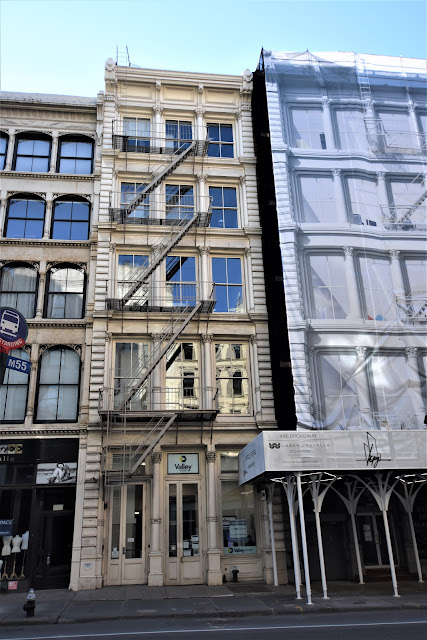The first wave of the redevelopment of the Broadway blocks just above Canal Street in the late 1830's. Theaters and commercial buildings took over or replaced the wooden and brick homes of a generation earlier. That phase ended following the Civil War as modern loft buildings were erected throughout the area.
 |
| The east side of Broadway between Howard and Grand Streets as it appeared in 1840. W. Robert's Half Way House occupied the two-story frame former residence at No. 450 (left). from the collection of the Museum of the City of New York |
Snook designed No. 450 as a narrower version of its sibling next door. Were it not for the quoined pilasters that separate the two buildings, they would appear as a single structure. The Corinthian columns of the storefront sat upon pedestals. Faced in cast iron, each of the four upper floors was clearly defined by a molded cornice. Corinthian columns separated the openings (quarter-round versions snuggled into the corners). An unusual touch was Snook's concave, paneled frieze below the terminal cornice which followed the lines of the curving lines of the brackets.
 |
| No. 450 Broadway was a half-version of Nos. 446-448. photo via triboroughmultifamily.com |
Work within apparel shops in the 19th century was miserably hot in the summer and grueling no matter what the season. In the spring of 1886 the employees of Fleisch & Co. walked out. The New York Times reported on May 13 that the firm had "compromised" with reduced hours of "9-1/2 and 10 hours a day."
It was around the same time that the Philadelphia-based Wright Bros. & Co. moved in. Makers of umbrellas, walking sticks and parasols, the firm was founded in 1816 and by 1885 had branches in Boston, Chicago and New York. It was considered that year to be "the oldest and at the same time the largest house in the umbrella trade," according to the Chicago Board of Trade. "Their parasols are always authority for correct styles and beautiful designs," it said.
In 1889, according to Clothier and Furnisher, Wright Bros. & Co. "now turn out something like one million umbrellas and parasols annually." The article recalled that in its more than 60 years existence, it had "never suspended operations, except for a few months at the outbreak of the rebellion, when they converted their establishment into a manufactory for army clothing, thereby giving employment to over 500 persons (mostly women), who would otherwise have suffered from lack of work."
 |
| This ad illustrated the firm's patented and adjustable umbrella tie. The New York Times deemed it "a marked improvement." Clothier and Furnisher August 1899 (copyright expired) |
The New-York Tribune was blunt in its account, saying that he "dropped dead last evening at Grand-st. and Broadway." The reporter for The Sun flexed his medical instincts, saying "He looked like a consumptive, and death may have been caused by internal hemorrhage." Oddly enough, in his pocket along with his bankbook and $43.70 (a little over $1,000 today), was his will. "It leaves all his property to his daughter, Grace Maria Cubbin, now 9 years old," noted The Sun.
Both Fleisch & Co. and Wright Bros. & Co. left No. 450 in the early to mid-1890's, and in 1897 the newly-formed Silberstein, Hecht & Co. moved in.
It was founded in part by Albert Lyman Silberstein, who had come to America from Prussia as a child in 1870. When he was 22-years old he started the Griffon Cutlery Co. across the street at Nos. 445-446 Broadway. His new Silberstein, Hecht & Co. manufactured and imported sterling silver "pocket cutlery" and safety razors.
Silberstein held the patent on the "Griffon" brand razor. His filing in September 1896 describes it as "readily adjusted to bring the blade in proper relation to the guard." The razor was presented in a fitted leather case with an instruction pamphlet and all the necessary accouterments--strop, replacement blades, and such.
 |
| Silberstein's no-nonsense patent drawings did not reflect the ornate chasing on the actual product. |
 |
| This sterling silver knife was an example of Silberstein, Hecht & Co.'s "pocket cutlery." photo via worthpoint.com |
In 1909 Gitenstein had branched out to join his brother Abraham and William J. Elsesser in a second company with a shirt factory at No. 256 Church Street. Not long after the factory was gutted by fire on June 3, 1912 Gitenstein was implicated in an arson plot.
Gitenstein did not remain through his entire seven-year lease. In 1922 the Cincinnati-based officer furniture manufacturer Globe-Wernicke Co. used the building as warehouse space. Then, in February 1940, textile brokers Walser & Wellisch Co. purchased the building. The New York Times reported "the new owner contemplates using the structure for his own business." By mid-century the firm was renamed the Wellisch Company.
As the Soho neighborhood changed from industrial to trendy, the street level shop followed suit. In hopes of supplementing her income, in 1979 artist Patti Paige blended her creative skills with her grandmother's cookie recipes and opened Baked Ideas here. Paige treated her wares as blank canvases, decorating them with portraits, depictions of architecture, cartoon characters, and more. As Valentine's Day approached on February 2, 1983 The New York Times food columnist Marian Burros reported "Single hearts, double hearts and cupids in spice, sugar and honey whole wheat, delicately decorated with bows and flowers and arrows, are being made by Baked Ideas."
Today a bank occupies the space. And overall John B. Snook's cast iron structure is little changed since the paint first dried in 1877.
photograph by the author

.png)

No comments:
Post a Comment